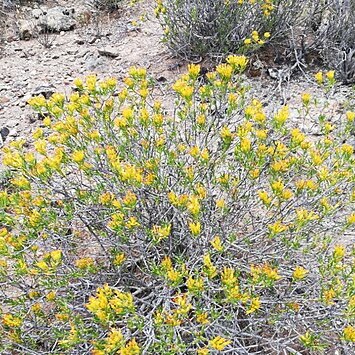Much-branched shrub, up to 1.5 m high. Leaves opposite, connate at base and encircling branchlet, long, linear, with recurved subobtuse apices, fleshy, glabrous, viscid. Capitula discoid, narrowly turbinate, several in crowded corymbs at branch tips; involucral bracts in ± 4 rows, imbricate, outer ones ovate-oblong, obtuse, inner ones oblanceolate, obtuse, all with narrow hyaline, jagged margins. Florets golden-yellow. Flowering time Aug.-Feb. Pappus of whitish, barbellate bristles, inner much broader than outer. Cypselae with long hairs.
Much-branched shrub, up to 1 m tall. Leaves opposite, fused at base and sheathing branchlet, long, linear, fleshy, glabrous, viscid, tips recurved, subobtuse. Flowerheads discoid, narrowly turbinate, several in crowded corymbs at branch tips; involucral bracts with narrow, hyaline, jagged margins; disc florets golden-yellow. Cypselas long-haired.
Much-branched shrub to 1 m. Leaves subterete, viscid, connate below around stem. Flower heads narrow, several in crowded corymbs at branch tips, golden-yellow, 10 x 3 mm.

